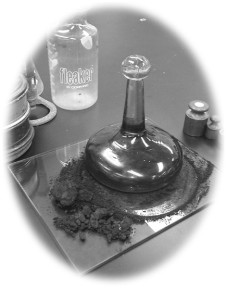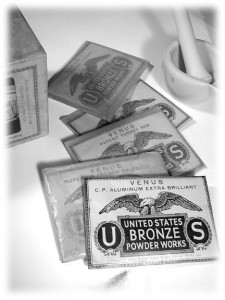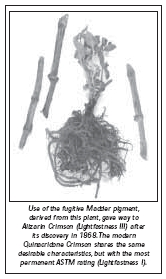Pigment is the very essence of paint. Regardless of the vehicle that is used to adhere it to the substrate, pigment selection is based on one simple criterion. The colorant must be the right hue. Once that factor is met, the artist can compare it to other available pigments of a like hue, and determine the one that is best suited for the project at hand. The final selection may be based on opacity, cleanliness, vibrancy, and of course, permanence.
Ever since the first prehistoric artist picked up a smoldering chunk of charcoal from the fireplace to draw on the cave wall, mankind has striven to produce better art. Each artist from that point on has faced the same question: “What materials will work the best for what I am trying to do?” In the case of early man, the answer was found in plants, dirt and other avail-able materials of the right color that could be crushed, ground or squeezed, and applied to the painting. In today’s world we have at our disposal an incredible number of materials in a vast array of hues.
From these, for use in artwork intended to last, we can choose colorants with an emphasis on permanence. If a painting’s characteristics are to remain consistent for generations to come, we can-
not remain indifferent to the fact that certain pigments are going to fade. Such pigments should not
be incorporated into a palette based on decisions made by artists centuries ago. Old choices should
be continuously compared to new alternatives, with selections based on current information. Similar reasoning can be applied with regard to the characteristic of pigment toxicity.
There are pigments that have survived for centuries as reliable and safe colorants. Some of the
inorganic pigments used since prehistoric times, such as the Ochres and Bone Black, are still in use today. Along with these, we long ago made room on the palette for their refined counterparts, synthetics such as Mars colors (Iron Oxides) and Carbon Black. We also have replaced many pigments on the palette, both naturally occurring and synthetic, with newer inventions. These additions and changes have collectively yielded improvements in color consistency, durability, safety, and range.
However, change does not come without skepticism and reluctance. Max Doerner reflected on this issue in his circa 1921 book, The Materials of the Artist: ‘It is often heard said among artists that the old masters had no “chemical” pigments, and for that reason their pictures are so well preserved. This, however, is a misconception, for the old masters had lead white, Naples Yellow, Vermilion, copper and sulphur colors, etc. The reason for the greater permanency of many of the old pictures lies in the fact that they were built up in a correct, craftsman like manner.’
The acceptance of new pigments for use in painting has always been subject to differing opinions. Then and now, as each new colorant appears, it ranges from rapid embracement to disdainfulness. A pigment may be readily used by some based solely on hue, while the more cautious will inquire as to its permanence. Historically, the latter group gained this information from the fate of the former. Innovators, at their own risk, proved or disproved the archival merit of materials. Followers could then couple this information with the aesthetic and working attributes of the new pigment to see if it met their criteria. However, the rate at which a new pigment gained acceptance was often greatly accelerated if it filled a previously vacant color space, regardless of other criteria.

This procedure of evaluating pigments formerly required generations, as time was the most reliable indicator of lightfastness. The careful artists of each time period used past experience to create the most permanent paintings of their day. However, with modern test methods, this no longer is the case. It is now the pigment and artists’ material manufacturer’s role to provide this information concurrent with the introduction of the colorant.
As new pigments are discovered, or as known ones are refined, todays artist can much more readily assess whether colors they currently are using, which have been so familiar to them, are still the
best possible choice. With the issue of durability much more assured, they are at greater liberty to pursue a new material based solely upon its representation of their vision.
New does not always mean better, but the discovery of cer-tain pigments were monumental. True Ultramarine Blue, or Lapis Lazuli was extremely expensive, but other than the translucent Smalt, there wasn’t an alternative for centuries. Prussian Blue was synthesized from ferric-ferrocyanide in 1704, and marks the first truly man-made pigment. It was accidentally made by the Berliner Diesbach 7, and was hailed as a great achievement by the artists and colourmen of the day. In retrospect, we can recognize that Prussian Blue was indeed a great replacement pigment, as it offered a durable, but much more economical intense blue. In contrast, the synthetic “coal tar” colors, although breakthroughs in color chemistry, were used too hastily. In 1856, 18 year-old William Henry Perkin was awarded a patent for discovering that coal tar bases could produce intense bright bluish purples. Although these dyes proved not to be lightfast, the chemistry involved paved the way for future successful organics. Shortly after this discovery, other chemists were stimulated by the methods used to produce them and carried out similar experiments, which soon led to dramatic discoveries. 8
 GOLDEN Pigment Selection for Acrylic Paints
GOLDEN Pigment Selection for Acrylic Paints
As a paint manufacturer, GOLDEN has always made products with the professional artist in mind. The pigments are carefully selected for clarity, consistency and permanence. In fact, every lot of pigment
we receive is pre-tested before use in our paints to ensure consistent color.
From time to time, artists will ask us why we don’t make historically produced colors. The choice not to make certain colors is based on one of several reasons. Sometimes the particular pigment is no longer commercially available. It is also true that certain pigments, such as Prussian Blue and Viridian Green, are not stable in acrylic emulsion paints. Other pigments may have an unacceptable level of toxicity. Often, as is the case with true Alizarin Crimson or Sap Green, our response is that we do not want to use pigments that do not have an ASTM Lightfastness rating of I or II. It is a very easy decision to eschew such colorants if lightfast alternatives exist in the same color space.
When alternatives do not exist, the most important attribute of a color, still may be… color. That is why GOLDEN sells fugitive Fluorescent paints and Phosphorescent Medium. They are truly unique. We also make it well known that these materials will not stand the test of time. One day there may in fact be fluorescent pigments that are lightfast. If and when that day comes, today’s pigments will be replaced. The attribute of being irreplaceable is likely the most valid argument for incorporating fugitive material into artwork, and comes at a known cost. Conversely, failure to embrace better replacements, when merited, may cost posterity that work which could otherwise have endured.
This argument is nothing new to the art world. Take for example the use of Madder. This plant’s root has been used for centuries as an artist pigment. The brilliant rose madder was extracted and processed into a “lake” (a lake pigment is made by using a substratum, typically a clay, as an inert base to absorb an ink-like colorant, so that it may be applied as a pigment1). In 1868, the German chemists, Grabe and Lieberman, first synthesized 1, 2 dihydroxyanthraquinone, or the color material in Madder, known as Alizarin. The process created a much more lightfast pigment 2. While some artists argued that the genuine Madder pigment was brighter, Alizarin’s permanency was so much greater that it immediately became the preference of most artists of the time. While the lightfastness was a great improvement, it is still only an ASTM category III pigment (Fair) by today’s standards.
In 1958, Struve discovered methods of preparing linear-transquinacridones in a form useful for pigments 3, which paved the way for development of the family of pigments we call Quinacridone. Just as the coaltar derivative Alizarin Crimson set a new standard for synthetic organic pigments, the development of Quinacridones made it possible to achieve the same desirable characteristics of the original Madder, but in a Lightfastness I (Excellent) pigment. As a result, GOLDEN is able to offer Quinacridone Crimson as a modern, and dramatically more permanent alternative.
Why Some Pigments are No longer Available
Many of the historical colors have become obsolete for a variety of reasons. Today’s pigments are not made with the artist in mind, but for the production of industrial coatings, such as house paints, appliances, and automotive paints. For this reason when a color is out of favor, or replaced by a cleaner, more lightfast pigment, production of the older pigment can be halted almost immediately. This was recently the case with GOLDEN Naphthamide (Benzimidazalone) Maroon. As new pigments of similar hue became available, that were either cheaper or easier to process, most industries stopped using Naphthamide. Hence, demand fell sharply, and it is no longer profitable for the pigment manufacturer to produce.
Ethics caused the disappearance of Indian Yellow. This pigment was commercially produced in Bengal, India by feeding the leaves of mango trees to cattle and collecting their urine. The dried product (chemically known as euxanthic acid) produced an intense, vibrant yellow that was used for years as a dye and an artist’s pigment 4. The process of feeding only mango leaves to cattle had adverse effects on the animal as they didn’t contain sufficient nutrients. In 1908, production of Indian Yellow was terminated as an act of the Indian Government, which prohibited the manufacturing as prevention of the cruelty of animals 5.
Toxicity may also cause a pigment to fall into disfavor. Pigments made from lead or mercury, such as Naples Yellow or Vermilion, can be poisonous and may have inadvertently killed many early artists. It is believed that Vincent Van Gogh’s mental illness and suicide may have been due, in part, to his frequent use of true Naples Yellow 6. Many of these very toxic pigments were replaced by the Cadmium family of pigments, which in turn are yielding to better choices in the evolution of pigment selection.
Although Cadmium is less toxic than lead and mercury, it is still a heavy metal with an uncertain future due to continued regulatory concern. As part of GOLDEN Artist Colors’ ongoing efforts to provide safe products, we have introduced several organic colors as replacements to the Cadmiums. These include Pyrrole Red, Pyrrole Red Light, Pyrrole Orange, and Hansa Yellow Opaque. In addition to being similar in hue and chroma, these colors have greater exterior durability than cadmium pigments.
References:
1. Doerner, Max, The Materials of the Artist. p. 47.
2. Gettens & Stout, Painting Materials. p. 126.
3. Zollinger, Heinrich, Color Chemistry. p. 193.
4. Gettens & Stout, Painting Materials. p. 119.
5. Feller, Robert L. Artist’s Pigments. p. 19-20.
6. Moss, Matthew. Caring for Old Masters Paintings. p. 78.
7. Gettens & Stout, Painting Materials. p. 149-150.
8. Zollinger, Heinrich. Color Chemistry. p. 4.
About Golden Artist Colors, Inc.
View all posts by Golden Artist Colors, Inc. -->Subscribe
Subscribe to the newsletter today!
No related Post

